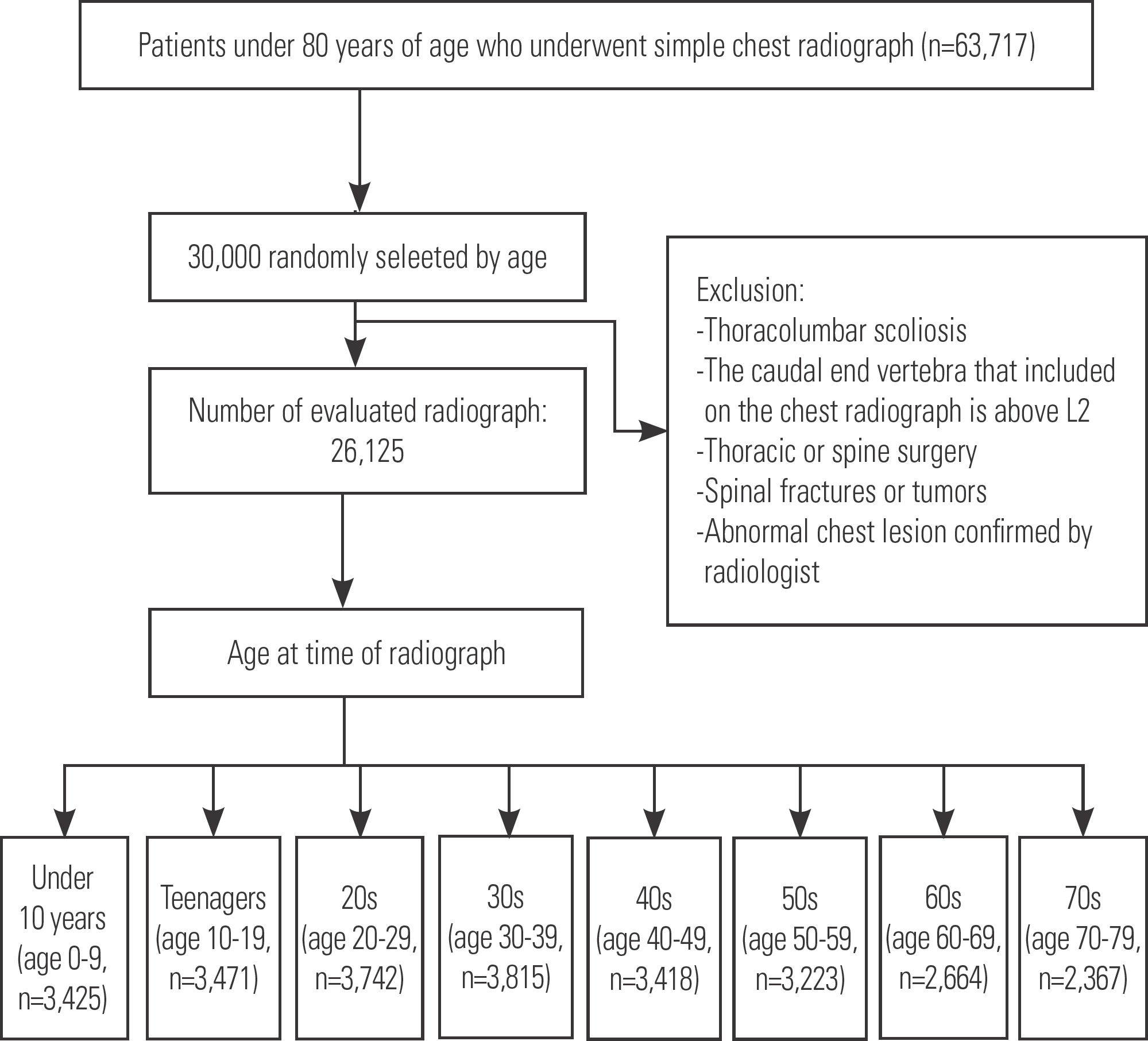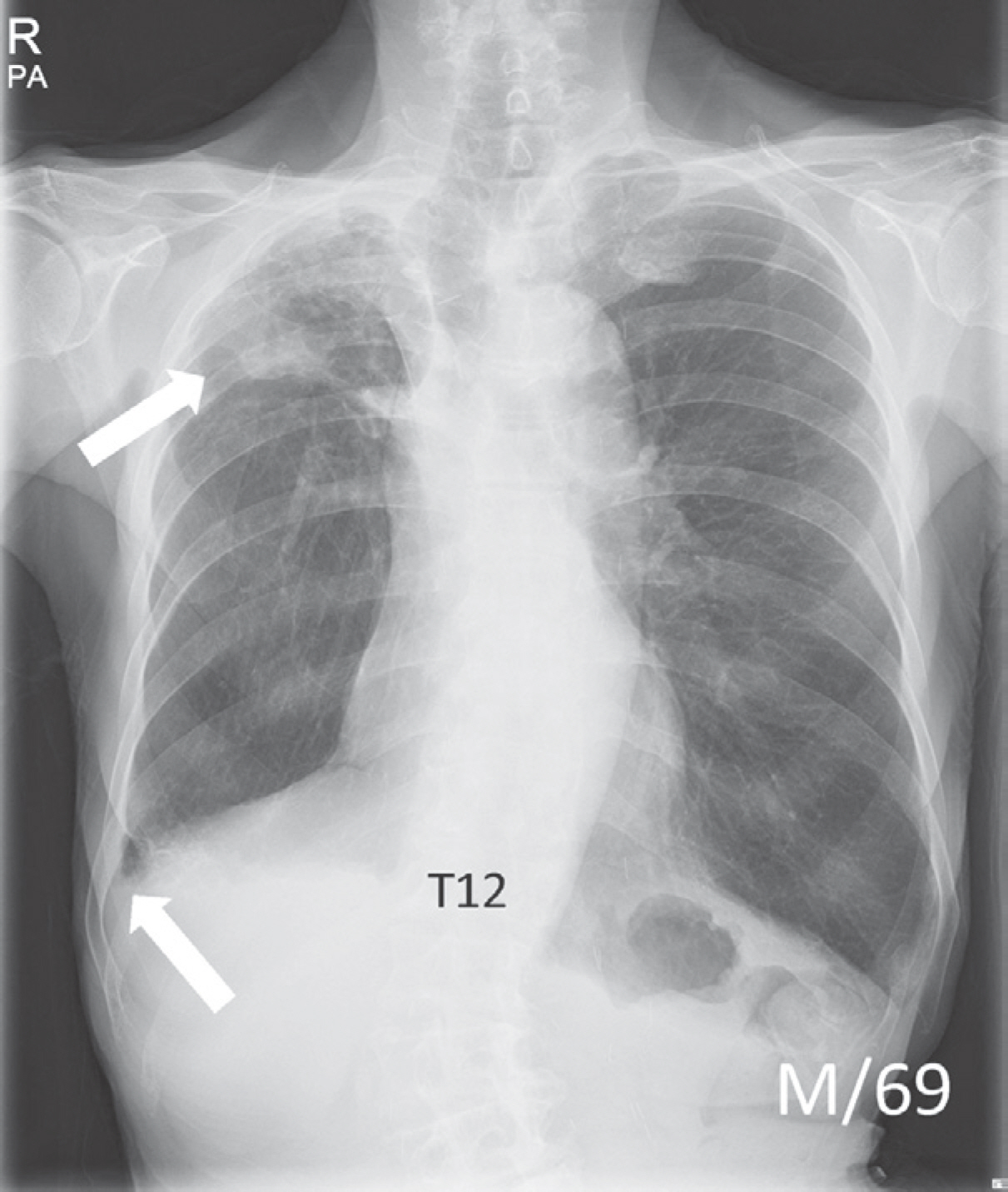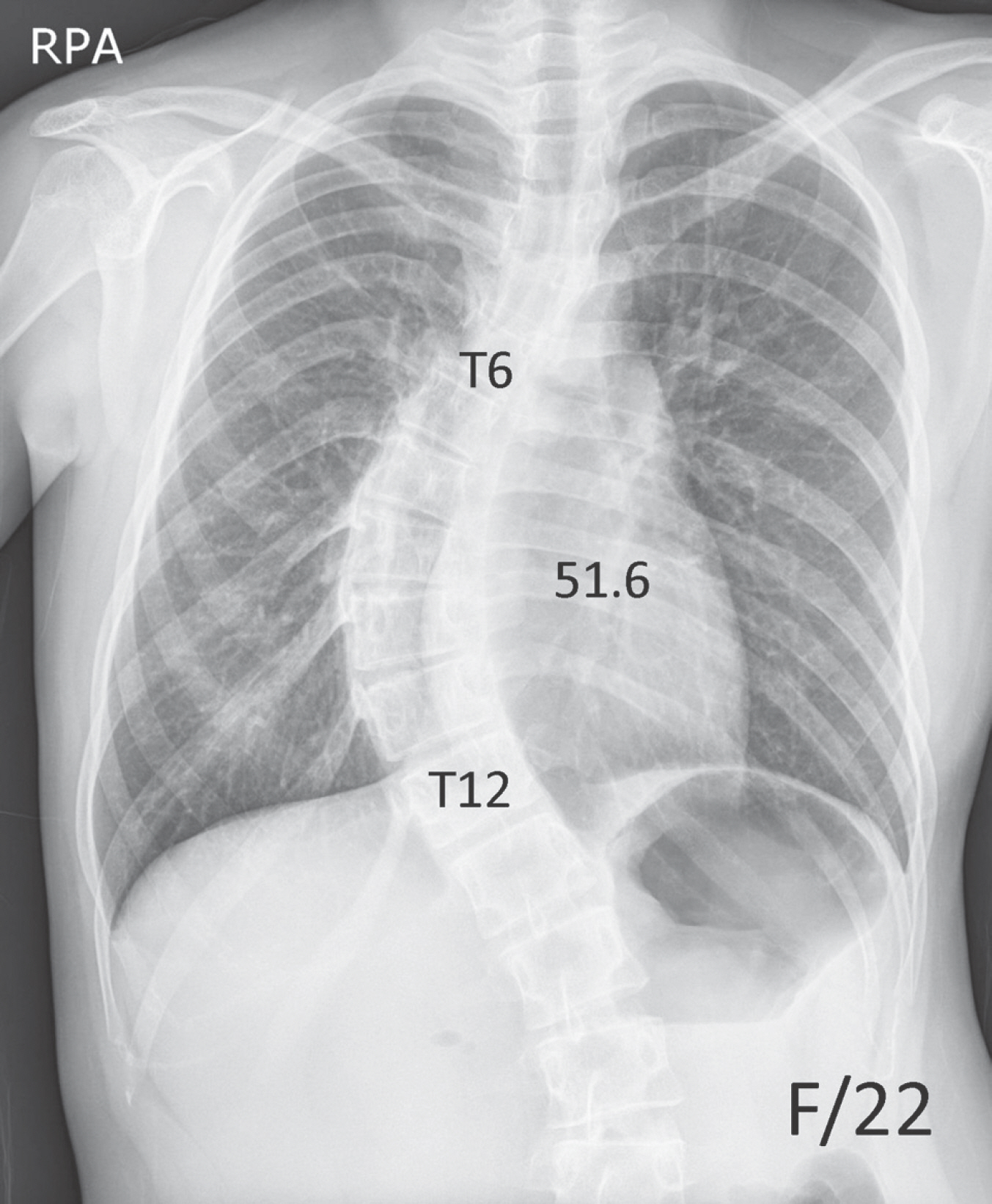J Korean Soc Spine Surg.
2019 Jun;26(2):56-62. 10.4184/jkss.2019.26.2.56.
Prevalence of Thoracic Scoliosis in Koreans Using Simple Chest Radiography
- Affiliations
-
- 1Department of Orthopaedic Surgery, Sanggye Paik Hospital, College of Medicine, Inje University, Seoul, Korea. spine@paik.ac.kr
- 2Department of Orthopaedic Surgery, CM Hospital, Seoul, Korea.
- 3Department of Orthopaedic Surgery, Seoul St. Mary's Hospital, College of Medicine, The Catholic University of Korea, Seoul, Korea.
- KMID: 2451314
- DOI: http://doi.org/10.4184/jkss.2019.26.2.56
Abstract
- STUDY DESIGN: A cross-sectional study.
OBJECTIVES
To provide reference data for the study and treatment of thoracic scoliosis. SUMMARY OF LITERATURE REVIEW: There have been no reports on the prevalence of thoracic scoliosis in Korea.
MATERIALS AND METHODS
From August 2011 to October 2012, radiographs of patients under 80 years of age who underwent routine chest radiographs were retrospectively reviewed. Based on their age when the chest radiographs were obtained, the patients were divided into 8 groups. The prevalence and angle of the curve of thoracic scoliosis were investigated in each age group, and the prevalence of thoracic scoliosis according to sex, the direction of the curve, number of vertebrae in the major curve, the location and rotation of the apical vertebrae, and osteophyte location were examined.
RESULTS
The prevalence of thoracic scoliosis was 2.4% (621 patients), and female patients (3.0%, 375 of 12471) showed a higher prevalence than male patients (1.8%, 246 of 13654) (p<0.001). Right curvature was present in 445 patients and left curvature in 176 patients. In each age group, the prevalence and degree of thoracic scoliosis were 1.1% (14.2°±3.2°), 2.3% (17.4°±7.7°), 2.5% (17.0°±8.9°), 1.9% (15.8°±5.9°), 1.3% (15.5°±6.6°), 2.1% (18.0°±13.6°), 2.9% (14.3°±3.6°), and 6.1% (16.2°±4.8°), respectively. The mean curvature in all scoliosis patients was 16.0°±7.0°. The angle of the curve was significantly different by sex (15.4°±7.1° for males, 16.8°±7.6° for females). The average curve angle of patients with thoracic scoliosis was 16.0°±7.0°, among whom it was 10°-20° in 533 patients, 20°-30° in 64, 30°-40° in 11, and over 40° in 13.
CONCLUSIONS
This study could be used as a reference point for the study and treatment of thoracic scoliosis.
Keyword
MeSH Terms
Figure
Reference
-
1. Kostuik JP, Bentivoglio J. The incidence of low back pain in adult scoliosis. Acta Orthop Belg. 1981 May; 6(3):268–73. DOI: 10.1097/00007632-198105000-00009.2. Kebaish KM, Neubauer PR, Voros GD, et al. Scoliosis in adults aged forty years and older: prevalence and relationship to age, race, and gender. Spine (Phila Pa 1976). 2011 Apr; 36(9):731–6. DOI: 10.1097/BRS.0b013e3181e9f120.3. Hong JY, Suh SW, Modi HN, et al. The prevalence and radiological findings in 1347 elderly patients with scoliosis. J Bone Joint Surg Br. 2010 Jul; 92(7):980–3. DOI: 10.1302/0301-620X.92B7.23331.
Article4. Schwab F, Dubey A, Gamez L, et al. Adult scoliosis: prevalence, SF-36, and nutritional parameters in an elderly volunteer population. Spine (Phila Pa 1976). 2005 May; 30(9):1082–5. DOI: 10.1097/01.brs.0000160842. 43482.cd.
Article5. Nash CL Jr., Moe JH. A study of vertebral rotation. J Bone Joint Surg Am. 1969 Mar; 51(2):223–9. DOI: 10.2106/00004623-196951020-00002.
Article6. Kim JH Suk SI, Chung ER, et al. Epidemiologic study of lumbar scoliosis with plain abdominal X-ray. J Korean Soc Spine Surg. 2004 Dec; 11(4):246–52. DOI: 10.4184/jkss.2004.11.4.246.
Article7. Carter OD, Haynes SG. Prevalence rates for scoliosis in US adults: results from the first National Health and Nutrition Examination Survey. Int J Epidemiol. 1987 (Dec); 16(4):537–44. DOI: 10.1093/ije/16.4.537.
Article8. Urrutia J, Besa P, Bengoa F. A prevalence study of thoracic scoliosis in Chilean patients aged 10-20 years using chest radiographs as a screening tool. J Pediatr Orthop B. 2018 (Mar); 27(2):159–62. DOI: 10.1097/BPB.0000000000000466.
Article9. Urrutia J, Zamora T, Klaber I. Thoracic scoliosis prevalence in patients 50 years or older and its relationship with age, sex, and thoracic kyphosis. Spine (Phila Pa 1976). 2014 (Jan); 39(2):149–52. DOI: 10.1097/BRS. 0000000000000095.
Article10. Chen JB, Kim AD, Allan-Blitz L, et al. Prevalence of thoracic scoliosis in adults 25 to 64 years of age de-tected during routine chest radiographs. Eur Spine J. 2016 Oct; 25(10):3082–7. DOI: 10.1007/s00586-015-4215-4.11. Pritchett JW, Bortel DT. Degenerative symptomatic lumbar scoliosis. Spine (Phila Pa 1976). 1993 May; 18(6):700–3. DOI: 10.1097/00007632-199305000-00004.
Article12. Grubb SA, Lipscomb HJ, Coonrad RW. Degenerative adult onset scoliosis. Spine (Phila Pa 1976). 1988 (Mar); 13(3):241–5. DOI: 10.1097/00007632-198803000-00004.
Article13. Kirkaldy-Willis WH, Farfan HF. Instability of the lumbar spine. Clin Orthop Relat Res. 1982 May; 165:110–23. DOI: 10.1097/00003086-198205000-00015.
Article14. Konieczny MR, Senyurt H, Krauspe R. Epidemiology of adolescent idiopathic scoliosis. J Child Orthop. 2013 Feb; 7(1):3–9. DOI: 10.1007/s11832-012-0457-4.
Article
- Full Text Links
- Actions
-
Cited
- CITED
-
- Close
- Share
- Similar articles
-
- Usefulness of Chest Radiographs for Scoliosis Screening: A Comparison with Thoraco-Lumbar Standing Radiographs
- Scoliosis and Congenital Heart disease
- Scoliosis in Children after Surgery for Congenital Heart Disease
- Prevalence and Insight of Scoliosis among Korean Male Adolescents by Chest Radiographs
- Scoliosis in a Nineteen Years Old Male: Prevalence Study




